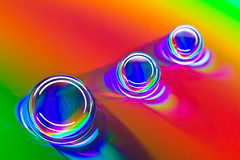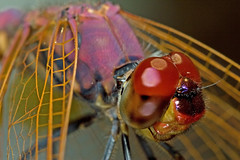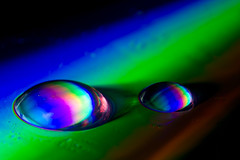Friday, March 30, 2007
Drops on a DVD series 2-2
My images will never stand out if I copy what's already been done.
On the way to work this morning it hit me that I could probably lay my MR-14 EX flash head right on top of a DVD if I used an off camera cord (I needed some room to move with the camera and not drag the flash head over the DVD). This image is the result of a little experimenting with different objects to raise the flash head off of the DVD (at one point I was using a lens cap).
Be different, experiment, and stand out...
Wednesday, March 28, 2007
Shooting dragonflies
Last year I spent a lot of time at Lago deAverno (lake of Averno) shooting dragonflies. There are several species of them but the most common is the Violet Darter in the photo. After a while you start to pick up on their habits and quirks, and you learn when you can get close and when you're wasting your time. The trick is to find one that's busy. If they are feeding, mating, or otherwise occupied then they are less likely to fly away. If they do fly off then just freeze -if the dragon comes back to the same spot (or close to it) then try again. If the critter lands several meters away from you then look for a new subject to shoot.
You won't get close if it keeps moving away from you.
If you try to get close to a dragonfly and it takes off then simply freeze, or back up a step and freeze. If the critter comes back to the same perch then odds are it didn’t take off because of you; it found something to eat and went after it. The trick is to move slowly and don’t vary your pace. Predators often move slowly at first, but speed up for the strike. Photographers often move slow at first but get excited as they get close to the subject –and the critter will take off because you’re moving like a predator…
Now that you’re getting close the dragonfly is getting use to you, and it’s not viewing you as a predator. So take your time and compose your shots carefully so you won’t feel the need to crop them later during post processing. If the dragon takes off just wait and see if it comes back. If you are very close (within inches / a few centimeters) then you might have to back up a little to get the dragonfly to come back to the same perch. Just keep your movements slow and even and when it lands move back in. Patience is the key to taking photos of dragonflies above life size –get into too big of a hurry and you’ll go home empty handed…
I normally go shooting in the heat of the day, when dragonflies are the most active and when I have a better chance of finding one that’s feeding (or a mating pare). If there is a particular species that won’t let you get close, or that seems to be constantly in motion, then go looking for it early in the morning when it’s still trying to dry out from the previous night’s dew.
I take almost all of my photos using either a flash as fill or as the primary light source, so the light from the flash doesn’t seem to bother them. The only trouble I’ve had with flash photography is getting so close to a dragonfly that I accidentally touched it with the flash ;)
I never wear bright clothes when I go shooting insects. I think it helps to blend in a little with the area where I’m shooting, so I try to stick to neutral colors. Grey is almost always a safe bet, but any color that comes close to the reeds, trees, and other plants that they perch on will help.
Be patient, be persistent, and push your luck. I dedicated that photo to Mark Plonsky -I got the inspiration to try my luck at getting really close after seeing one of his images. The glass on my lens was less than 13 centimeters (5 inches) away from the dragonfly. Shot hand held with a 20D, 100mm macro lens, 37mm of extension tubes (for 1.6 times life size) and an MT-24 macro flash.
Practice, lots of practice... ;)
Tuesday, March 27, 2007
I shoot RAW -and so should you...
The RAW shooters were right.
Even though I spend all of sixty seconds editing any one image, shooting RAW has improved the quality of my photos -and I should have known better. I'm a geek, so I know that jpg is a "lossy" form of file compression: In order to compress an image a jpg converter tosses out data that is irrelevant.
Every time a file is saved as a jpg image data is lost.
Even though I don't do much editing, I do have to make a few changes and then save my image as a jpg. So the camera tosses out data when it compresses an image to make a jpg, and then I toss out data when I edit and save the image. It doesn't matter if the final file is larger than the original, detail is lost.
I was paying the compression penalty twice.
With macro photography the difference between shooting jpg and shooting RAW is huge, because with macro getting the most detail in an image is important. Details are lost when the camera creates a jpg, and even more are lost once edits are made on a computer and another jpg is cut. By shooting RAW I only risk losing fine details one time, and the jpg conversion in Photoshop Elements is better than the in camera jpg compression at preserving image data. In reality all of my images are sharper, even the scenic photos.
So now I only shoot RAW -and so should you...
Monday, March 26, 2007
Water Drops on a DVD series 1-1
Take a DVD and coat a small area on it, just larger than you're going to film, with canola or some other cooking oil. Then put a couple of drops of water on top of the oily surface -the oil will increase the surface tension between the water and the DVD, so that the water doesn't flatten out as much.
Now take the cardboard from a 4x6 inch photo paper package and wrap it in aluminum foil. No need to be gentle, since you don't really want a perfectly smooth surface. Use a rubber band to attach it to your flash, and bend the last few centimeters of it at a 90 degree angle. Bend your flash head at about 45 degrees and lay the whole thing down over a DVD so that the flash head is past the water drop. The trick is to get a lot of light on the DVD but not get a reflection from the flash.
The final image was converted from RAW with no changes and I used Noise Ninja to pull out sensor noise. Saved it as a jpg and I was done...
Why the title?
And you shouldn't either.
Now don't get me wrong: I'm not saying that all cropping is bad. If you look at a scene and see a panorama, but don't have the means to shoot several frames and stitch them together, then cropping that one image into a standard panorama format may be your only option. But you shouldn't put the camera to your eye and press the shutter release thinking that if you don't get the framing just right then you can always crop the photo later.
That would make you lazy.
Bad habits are easy to get into, but difficult to break. If you get into the habit of cropping all your images then you'll never put a lot of effort into composition or framing. Why should you when you can just crop it later, right? It's all good until someone asks you for an uncropped image and you don't have it, or the image you give them doesn't work because the composition is off. Start shooting photos for a stock agency and you'll find out just how painful that cropping habit can be. What if there isn't a single image in your portfolio that the agency can use because you always crop?
The viewfinder on my camera, and the size of its sensor, are my only crop -if I don't nail the composition and framing when I take the shot then the image goes into the bit bucket and I try again next time. I'm forced to wait for the right moment, to check and double check what I'm seeing, to look for different angles, or to get faster at composing my images correctly (shoot bees -they'll make you humble). The end result is that I have images that no one else has because sometimes cropping later, on the computer, doesn't work.
Welcome to the no cropping zone.



